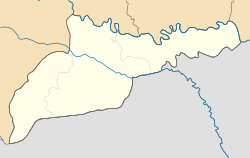Voloka (Ukrainian: Волока; Romanian: Voloca pe Derelui or Voloca) is a village in Chernivtsi Raion, Chernivtsi Oblast, Ukraine. It hosts the administration of Voloka rural hromada, one of the hromadas of Ukraine.[1]
Voloka
Волока | |
|---|---|
Village | |
 | |
| Coordinates: 48°11′41″N 25°56′34″E / 48.19472°N 25.94278°E | |
| Country | |
| Oblast | Chernivtsi Oblast |
| Raion | Chernivtsi Raion |
| Hromada | Voloka rural hromada |
| Elevation | 193 m (633 ft) |
| Population | |
• Total | 3,035 |
| Postal code | 60413 |
The current population of the village is 3,035[2] (3,028 at the time of the 2001 Ukrainian census).[3]
Most inhabitants are Romanians and they are almost exclusively engaged in the creation of bridal gowns, a business that has proved quite successful in the past decade, as the village has managed to make a name for itself in almost all of Ukraine and Russia as well as Romania.[4]
Until 18 July 2020, Voloka belonged to Hlyboka Raion. The raion was abolished in July 2020 as part of the administrative reform of Ukraine, which reduced the number of raions of Chernivtsi Oblast to three. The area of Hlyboka Raion was merged into Chernivtsi Raion.[5][6] In 2001, 97.56% of the inhabitants of Voloka spoke Romanian as their native language (2,960 called it Romanian, or 97.53%, and 1 called it Moldovan, or 0.03%), while 2.08% spoke Ukrainian.[7] In the 1989 census, the number of residents who declared themselves Romanian plus Moldovan was 2,907 (1,060 Romanians, or 33.68%, plus 1,847 Moldovans, or 58.69%), representing 92.37% of the locality's population of 3,147.[8] A large majority of the population switched their declared census identities from Moldovan and Moldovan-speaking to Romanian and Romanian-speaking between the 1989 and 2001 censuses.[9]
In 2001, the Volokivska or Voloka rural community had 6,086 inhabitants, including 4,919 Romanian-speakers (80.82%, including 4,749 self-identified Romanian-speakers, or 78.03% and 170 self-identified 170 Moldovan-speakers, or 2.79%), 1,090 Ukrainian-speakers (17.91%), and 55 Russian-speakers (0.9%).[10] In addition to the villages of Voloka and Valia Kuzmyna, it also included the village of Hrushivka village (see the Romanian-language Wikipedia article on Hrushivka at https://ro.wiki.x.io/wiki/Gru%C8%99%C4%83u%C8%9Bi,_Ad%C3%A2ncata). According to the 2001 Ukrainian census, the majority of the population of 1,187 people of Hrushivka was Romanian-speaking (97.98% or 1,163 people, including 1,144 self-identified Romanian-speakers, or 96.38%, and 19 self-identified Moldovan-speakers, or 1.6%), with a minority of Ukrainian speakers (1.43%, or 17 people) and of Russian-speakers (0.51%, or 6 people).[11] In the 1989 census, the number of residents who declared themselves Romanian plus Moldovan was 1,089, or 96.71% (495 Romanians, or 43.96%, plus 594 Moldovans, or 52.75%), but there were also 17 Ukrainians (1.51%) and 6 Russians (0.53%).[12] A majority of the population switched their declared census identities from Moldovan and Moldovan-speaking to Romanian and Romanian-speaking between the 1989 and 2001 censuses.[13]
In 2001, out of 6,086 individuals who lived in the Voloka rural hromada, 1,090 were Ukrainian-speaking (17.91%), 4,929 were Romanian-speaking (80.99%), including 4,759 who called the language Romanian (78.2%) and 170 who called it Moldovan (2.79%), and 40 were Russian-speaking (0.66%).[14] In 1989, out 5,928 inhabitants, 821 (13.85%) were ethnic Ukrainians, 1,693 were ethnic Romanians (28.56%), 3,348 were ethnic Moldovans (56.48%) and 44 were Russians (0.74%).[15] A majority of the Romanian plus Moldovan population switched their declared census identities from Moldovan and Moldovan-speaking to Romanian and Romanian-speaking between the 1989 and 2001 censuses.[16]
References
edit- ^ "Волоковская громада" (in Russian). Портал об'єднаних громад України.
- ^ "с Волока Чернівецька область, Глибоцький район (Voloka village, Chernivtsi region, Hlybotskyi district)" (in Ukrainian). Archived from the original on 2007-03-10.
- ^ "World Gazetteer: Chernivets'ka - largest cities (Per geographical entity)". www.world-gazetteer.com. Archived from the original on 5 January 2013. Retrieved 27 April 2022.
- ^ "PhotoRaid 2005 Agale prin Bucovina".
- ^ "Про утворення та ліквідацію районів. Постанова Верховної Ради України № 807-ІХ". Голос України (in Ukrainian). 2020-07-18. Retrieved 2020-10-03.
- ^ "Нові райони: карти + склад" (in Ukrainian). Міністерство розвитку громад та територій України.
- ^ The Ukrainian census of 2001, language data by localities, at https://socialdata.org.ua/projects/mova-2001/
- ^ Ion Popescu and Constantin Ungureanu, Romanii din Ucraina - intre trecut si viitor, vol. 1 (Romanii din Regiunea Cernauti), Cernauti, 2005, p. 217.
- ^ Ion Popescu and Constantin Ungureanu, Romanii din Ucraina - intre trecut si viitor, vol. 1 (Romanii din Regiunea Cernauti), Cernauti, 2005, p. 257.
- ^ The Ukrainian census of 2001, language data by localities, at https://socialdata.org.ua/projects/mova-2001/
- ^ The Ukrainian census of 2001, language data by localities, at https://socialdata.org.ua/projects/mova-2001/
- ^ Ion Popescu and Constantin Ungureanu, Romanii din Ucraina - intre trecut si viitor, vol. 1 (Romanii din Regiunea Cernauti), Cernauti, 2005, p. 217.
- ^ Ion Popescu and Constantin Ungureanu, Romanii din Ucraina - intre trecut si viitor, vol. 1 (Romanii din Regiunea Cernauti), Cernauti, 2005, p. 257.
- ^ The Ukrainian census of 2001, language data by localities, at https://socialdata.org.ua/projects/mova-2001/
- ^ Ion Popescu and Constantin Ungureanu, Romanii din Ucraina - intre trecut si viitor, vol. 1 (Romanii din Regiunea Cernauti), Cernauti, 2005, p. 217.
- ^ Ion Popescu and Constantin Ungureanu, Romanii din Ucraina - intre trecut si viitor, vol. 1 (Romanii din Regiunea Cernauti), Cernauti, 2005, p. 257.



